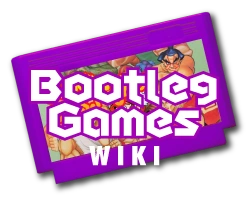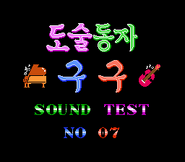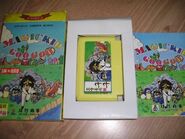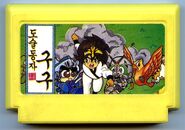(The sound driver IS a Konami sound engine; Jun Funahashi's to be specific) Tags: Visual edit apiedit |
No edit summary |
||
| (40 intermediate revisions by 11 users not shown) | |||
| Line 1: | Line 1: | ||
| + | {{Infobox game |
||
| − | {{Infobox game|name = Magic Kid Googoo|caption = Title screen|publisher = Zemina|developer = Zemina|console = Famicom/NES|date = 1992|sound = Konami/Jun Funahashi|image = File:Magic Kid Googoo (K) -!--0.png}} |
||
| + | |name = Magic Kid Googoo<br>도술동자 구구 |
||
| ⚫ | |||
| + | |image = File:Magickidgoogoo-fc-titleA.gif |
||
| + | |imagewidth = 250px |
||
| + | |caption = Title screen. |
||
| + | |publisher = [[Zemina]] or [[Haitai Electronics|Haitai]](?) |
||
| + | |developer = Zemina |
||
| + | |console = Famicom |
||
| + | |date = May-June 1992 |
||
| + | |sound = Konami (''Tiny Toon Adventures'')/Jun Funahashi |
||
| + | }} |
||
| ⚫ | |||
== Overview == |
== Overview == |
||
| − | [[File:Magic Kid Googoo (K) -!--2.png|left|thumb| |
+ | [[File:Magic Kid Googoo (K) -!--2.png|left|thumb|Gameplay.]] |
| − | In this game, the main character is a kid named Googoo (who seems to be wearing a karate uniform) and its attack ability consists on lifting rocks and throwing them at enemies or pots that contain items such as magic capsules, money (called as "food") or a letter (if the player collects all the letters |
+ | In this game, the main character is a kid named Googoo (who seems to be wearing a karate uniform) and its attack ability consists on lifting rocks and throwing them at enemies or pots that contain items such as magic capsules, money (called as "food") or a letter (if the player collects all the letters to form the word EXTRA, an extra life is rewarded). By pressing select Googoo can use special powers or turn into other temporary characters (the latter consumes magic pills). "Food" is collected through the levels or by playing the bonus minigames, and it includes an item shop as well, accessible after quitting from a minigame. The game contains 7 worlds, each of them with a boss after a temple level and a password to access directly. Passwords for each world are the following: |
| − | * |
+ | *World 1: MAGIC |
| − | * |
+ | *World 2: TIGER |
| − | * |
+ | *World 3: ORGAN |
| − | * |
+ | *World 4: STICK |
| − | * |
+ | *World 5: BOARD |
| − | * |
+ | *World 6: EAGLE |
| − | * |
+ | *World 7: MOUTH |
== Trivia == |
== Trivia == |
||
| + | *The game will reward the player with more lives instead of one if he gets the EXTRA letters in certain orders. |
||
| − | * The game includes a sound test option accessible through the title screen. It contains all the music tracks used, which is a feature present only in a few unlicensed games aside from this one.[[File:Magic Kid Googoo (K) -!--1.png|thumb|220x220px|Sound test screen]] |
||
| + | *Zemina started to work on the Famicom in August 1991. It took them a month to figure out on how to develop for the console and make the necessary tools. Googoo's development ended on May 5, 1992. |
||
| ⚫ | |||
| + | *The game was fully reviewed in GameWorld 6 and 7 in 1992, a Korean gaming magazine. |
||
| ⚫ | |||
| ⚫ | *Another interesting title screen option is a staff screen. Some of the developers shown parted ways to found [[Open Corp.]] and are also shown in the credits for ''[[Koko Adventure]]'', which uses the same HUD from this game but simplified. Koo Eun Joong, the programmer, stated that Koko was the spiritual successor to ''Magic Kid Googoo''. In the first stage of the third world, OPEN is written using candies. Suggesting the developers had already planned their future after finishing Googoo. |
||
| ⚫ | |||
| + | *Twin Mouse, developed by Open Corp around 1994 has all of the music based on ones from ''Magic Kid Googoo''. |
||
| + | *The invincibility music was also reused for Super Trio, an 1994 arcade game by Gameace. |
||
| + | *A Sound test option is available on the title screen, which is uncommon for unlicensed games. |
||
| + | *Pressing Start + Select simultaneously on the first controller kills the player. |
||
| + | *[[Haitai Electronics|Supercom]] logo appears on the box. Haitai likely paid Zemina for it to be featured on the box front and spine. |
||
| + | *The 패밀리(Family) and 슈퍼콤(Supercom) printed on the box are a sign of compatibility software between Famicom and Supercom (Haitai Electronics Famicom Clone). |
||
| + | *Googoo's design as seen on the box is loosely based on Wataru from ''Mashin Eiyuuden Wataru''. |
||
| + | |||
| + | == Gallery == |
||
| + | <gallery> |
||
| + | Magic Kid Googoo (K) -!--1.png|Sound test screen. |
||
| + | 8862_2.jpg|Complete box of the game. |
||
| + | IMG_6615.JPG|Cartridge front, courtesy of gamehistory.org. |
||
| + | </gallery> |
||
| + | |||
| + | {{Zemina Games}} |
||
[[Category:Games]] |
[[Category:Games]] |
||
[[Category:Famicom/NES games]] |
[[Category:Famicom/NES games]] |
||
[[Category:Platform games]] |
[[Category:Platform games]] |
||
| + | [[Category:Zemina]] |
||
| + | [[Category:1992 video games]] |
||
Revision as of 19:22, 13 July 2020
Magic Kid Googoo (도술동자 구구) is a Korean unlicensed platform game developed by Zemina in 1992 for the Famicom. From Zemina's history of games they released, this is the only game for the aforementioned console.
Overview
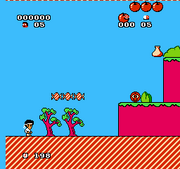
Gameplay.
In this game, the main character is a kid named Googoo (who seems to be wearing a karate uniform) and its attack ability consists on lifting rocks and throwing them at enemies or pots that contain items such as magic capsules, money (called as "food") or a letter (if the player collects all the letters to form the word EXTRA, an extra life is rewarded). By pressing select Googoo can use special powers or turn into other temporary characters (the latter consumes magic pills). "Food" is collected through the levels or by playing the bonus minigames, and it includes an item shop as well, accessible after quitting from a minigame. The game contains 7 worlds, each of them with a boss after a temple level and a password to access directly. Passwords for each world are the following:
- World 1: MAGIC
- World 2: TIGER
- World 3: ORGAN
- World 4: STICK
- World 5: BOARD
- World 6: EAGLE
- World 7: MOUTH
Trivia
- The game will reward the player with more lives instead of one if he gets the EXTRA letters in certain orders.
- Zemina started to work on the Famicom in August 1991. It took them a month to figure out on how to develop for the console and make the necessary tools. Googoo's development ended on May 5, 1992.
- The game was fully reviewed in GameWorld 6 and 7 in 1992, a Korean gaming magazine.
- Another interesting title screen option is a staff screen. Some of the developers shown parted ways to found Open Corp. and are also shown in the credits for Koko Adventure, which uses the same HUD from this game but simplified. Koo Eun Joong, the programmer, stated that Koko was the spiritual successor to Magic Kid Googoo. In the first stage of the third world, OPEN is written using candies. Suggesting the developers had already planned their future after finishing Googoo.
- The sound engine is based off Tiny Toon Adventures by Konami, which was later used in Open Corp.'s Famicom games.
- Twin Mouse, developed by Open Corp around 1994 has all of the music based on ones from Magic Kid Googoo.
- The invincibility music was also reused for Super Trio, an 1994 arcade game by Gameace.
- A Sound test option is available on the title screen, which is uncommon for unlicensed games.
- Pressing Start + Select simultaneously on the first controller kills the player.
- Supercom logo appears on the box. Haitai likely paid Zemina for it to be featured on the box front and spine.
- The 패밀리(Family) and 슈퍼콤(Supercom) printed on the box are a sign of compatibility software between Famicom and Supercom (Haitai Electronics Famicom Clone).
- Googoo's design as seen on the box is loosely based on Wataru from Mashin Eiyuuden Wataru.
Gallery
| List of games by Zemina |
|---|
|
